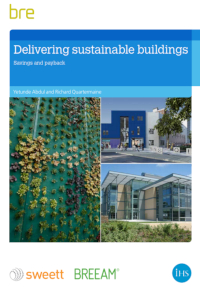Delivering sustainable buildings: Savings and payback FB 63
Delivering sustainable buildings: Savings and payback (FB 63) was written by Yetunde Abdul and Richard Quartermaine and published by BRE in August 2014. BRE (Building Research Establishment) is an independent, research-based consultancy, testing and training organisation, operating in the built environment and associated industries.
Research by Sweett Group and BRE has challenged the perception that sustainable buildings are more costly to build. Detailed capital and operational cost information was been obtained by applying cost data from real construction projects to three case studies (an office, a secondary school and a community healthcare centre).
The project investigated the capital costs of design and construction strategies that enhance building sustainability and help to achieve BREEAM ratings. They include low-cost or no-cost actions that can be used to enhance building sustainability, and those initiatives that must be built into the project at the concept stage to minimise their costs.
The research team also examined the life-cycle costs of operating buildings, focusing on energy and water consumption. They found that specifying sustainability measures during the building’s design and procurement stage can result in cost savings over the operational life of the building for little or no additional upfront cost.
The effect on capital costs of achieving varying levels of sustainability was calculated, including the costs associated with gaining Pass, Good, Very Good and Excellent BREEAM ratings outlined. Achieving lower BREEAM ratings can incur little or no additional costs. Targeting the higher BREEAM ratings incurs some additional cost but this is typically less than 2%. The study of operational costs shows that this can be paid back within 2–5 years through utility savings.
This project adds to a growing body of evidence on the costs and value of sustainability and supports the findings that:
- Where properly implemented, sustainability strategies add little to capital costs.
- Operational savings will pay back these costs.
- There is a downward trend in sustainability costs.
- A sustainable approach can enhance the quality and values of a development.
The contents of the 52 page report are:
- Executive summary.
- Introduction.
- Our approach.
- Case study 1: Office.
- Case study 2: Secondary school.
- Case study 3: Community healthcare centre.
- Discussion.
- Appendix A: Capital and life cycle modelling and assumptions.
- Appendix B: Assessment timeline.
- References and further reading.
- Glossary.
[edit] Related articles on Designing Buildings Wiki
- BRE articles on Designing Buildings Wiki.
- BRE Buzz articles on Designing Buildings Wiki.
- BREEAM Responsible sourcing of materials.
- BREEAM.
- Building Research Establishment.
- Capital costs.
- Climate change science.
- Green building.
- Mean lean green.
- Operating costs.
- Sustainability.
- Sustainable development.
- Sustainable materials.
- Sustainable procurement.
Featured articles and news
One of the most impressive Victorian architects. Book review.
RTPI leader to become new CIOB Chief Executive Officer
Dr Victoria Hills MRTPI, FICE to take over after Caroline Gumble’s departure.
Social and affordable housing, a long term plan for delivery
The “Delivering a Decade of Renewal for Social and Affordable Housing” strategy sets out future path.
A change to adoptive architecture
Effects of global weather warming on architectural detailing, material choice and human interaction.
The proposed publicly owned and backed subsidiary of Homes England, to facilitate new homes.
How big is the problem and what can we do to mitigate the effects?
Overheating guidance and tools for building designers
A number of cool guides to help with the heat.
The UK's Modern Industrial Strategy: A 10 year plan
Previous consultation criticism, current key elements and general support with some persisting reservations.
Building Safety Regulator reforms
New roles, new staff and a new fast track service pave the way for a single construction regulator.
Architectural Technologist CPDs and Communications
CIAT CPD… and how you can do it!
Cooling centres and cool spaces
Managing extreme heat in cities by directing the public to places for heat stress relief and water sources.
Winter gardens: A brief history and warm variations
Extending the season with glass in different forms and terms.
Restoring Great Yarmouth's Winter Gardens
Transforming one of the least sustainable constructions imaginable.
Construction Skills Mission Board launch sector drive
Newly formed government and industry collaboration set strategy for recruiting an additional 100,000 construction workers a year.
New Architects Code comes into effect in September 2025
ARB Architects Code of Conduct and Practice available with ongoing consultation regarding guidance.
Welsh Skills Body (Medr) launches ambitious plan
The new skills body brings together funding and regulation of tertiary education and research for the devolved nation.
Paul Gandy FCIOB announced as next CIOB President
Former Tilbury Douglas CEO takes helm.
























